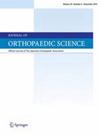肘关节慢性PLRI的尺侧副韧带重建增强二级稳定剂提供了良好到优异的临床效果,无复发性不稳定。
IF 1.5
4区 医学
Q3 ORTHOPEDICS
引用次数: 0
摘要
目的:慢性肘关节PLRI采用尺外侧副韧带重建术治疗。然而,初次重建后最常见的并发症是复发性不稳定-高达25%。因此,我们假设,与仅进行一次重建的技术相比,增强二次稳定剂将提供成功的结果,并且复发不稳定性的发生率更低。本研究旨在展示一种涉及二级稳定剂的新型手术技术。方法:对29例慢性PLRI患者进行回顾性研究,平均症状持续时间为39.6±4.9个月。平均年龄47.9岁,以男性为主。手术由同一家机构的一位资深外科医生进行。记录Mayo肘部功能评分(MEPS)和臂、肩、手残疾问卷(DASH)。结果:平均随访36.8±7.7个月。MEPS评分由59.8±13.1分提高至84.7±7.6分(p 75分)。DASH评分从40.8±4.6提高到20.9±7.2 (p)。结论:采用邻接自体移植物增强二级稳定剂效果良好,无复发性不稳定。这种新颖的手术方法易于复制,与仅进行初级重建的技术相比,在慢性PLRI病例中提供了一种安全可靠的替代方法。本文章由计算机程序翻译,如有差异,请以英文原文为准。
Lateral ulnar collateral ligament reconstruction enhancing secondary stabilizers in chronic PLRI of the elbow provides good to excellent clinical results with no recurrent instability
Purpose
The adopted treatment for chronic elbow PLRI is lateral ulnar collateral ligament reconstruction. However, the most frequently reported complication after primary reconstruction is recurrent instability – up to 25 %. It was thus hypothesized that enhancing the secondary stabilizers will provide successful results with a lower rate of recurrent instability in comparison to techniques with primary reconstruction only. This study aimed to demonstrate a novel surgical technique involving secondary stabilizers.
Methods
In this retrospective study of 29 cases with chronic PLRI the mean duration of symptoms was 39.6 ± 4.9 months. The mean age was 47.9 years with mainly male patients. The surgeries were performed by one senior surgeon at a single institution. The Mayo Elbow Performance Score (MEPS) and the Disabilities of the Arm, Shoulder and Hand questionnaire (DASH) were recorded.
Results
The mean follow-up was 36.8 ± 7.7 months. The MEPS score improved significantly from 59.8 ± 13.1 to 84.7 ± 7.6 (p < 0.001). 23/29 patients (79.2 %) had converted to good and excellent results (MEPS >75 points). The DASH score improved from 40.8 ± 4.6 to 20.9 ± 7.2 (p < 0.001). The total complication rate was 10.3 % (N = 3). No recurrent instability was recorded in comparison to 12.2 % for primary reconstruction only, as reported in the literature (p < 0.05).
Conclusion
Enhancing the secondary stabilizers by utilizing an adjacently located autograft provided good and excellent results with no recurrent instability. This novel surgical procedure is easy to reproduce and provides a safe and reliable alternative in cases of chronic PLRI when compared to techniques with primary reconstruction only.
求助全文
通过发布文献求助,成功后即可免费获取论文全文。
去求助
来源期刊

Journal of Orthopaedic Science
医学-整形外科
CiteScore
3.00
自引率
0.00%
发文量
290
审稿时长
90 days
期刊介绍:
The Journal of Orthopaedic Science is the official peer-reviewed journal of the Japanese Orthopaedic Association. The journal publishes the latest researches and topical debates in all fields of clinical and experimental orthopaedics, including musculoskeletal medicine, sports medicine, locomotive syndrome, trauma, paediatrics, oncology and biomaterials, as well as basic researches.
 求助内容:
求助内容: 应助结果提醒方式:
应助结果提醒方式:


